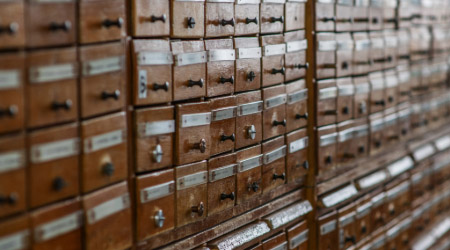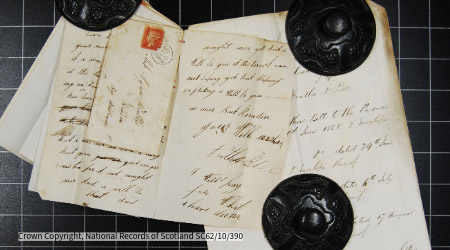Learning Zone - The Register of Deeds
How is the Register of Deeds Arranged?
Quick facts
Deeds can be very useful to the family historian. I am going to explain a little about deeds here, specifically how to find deeds in the ‘Books of Council and Session’ or as it is less formally described, the ‘Register of Deeds’. Please note that what follows has been written to help you trace your Scottish family tree and is not written to help you understand the law. If you are looking for help to understand Scots law we would recommend looking at the website of the Stair Society. The Register of Deeds was just one place a person could register a deed, deed registers were also kept by Sheriff Courts, Burgh Courts and Commissary Courts.
A Word About Deeds
Deeds were created by our ancestors for various purposes, they are legal documents which record a wide variety of transactions. As you might expect, common types of deeds relate to financial and business matters, these could be bonds, contracts of sale or contracts of partnership to name but a few.
Some deed types are of special interest to those researching their family tree and deserve special mention here. Marriage contracts are sometimes recorded in the Register of Deeds and can be extremely useful if you are fortunate enough to find one relating to your ancestor. Other deed types to look out for are those where an individual sought to make provision for his family members after his death. Sometimes, deeds described as a ‘Latter Will and Testament’, or simply a ‘Settlement’ can be found, and these documents were not always also recorded in the Registers of Testaments (as indexed on Scotland’s People) as one might expect. ‘Trust Disposition & Settlements’ are also very useful as this particular type of legal document was used to transfer ‘heritable property’ (such as land, buildings, minerals and mining rights). Other documents which may contain family information of this kind may be entitled ‘Bond of Provision’, or Disposition and Assignation’, and if the surnames of the granter and the grantee are the same, it may be worth checking to see if this is a deed where someone was seeking to make financial provision for their family members. Prior 1868 ‘heritable property’ could not be bequeathed in a Scottish testament. Finally, it is also worth mentioning that there are some ‘indentures’ which record apprenticeships.
Whatever the reason your ancestors registered a deed, they can all potentially give us clues that can be desperately needed to trace your family tree. In the text of the deed itself, a full designation is almost always given for each party and this can often include the name of a person’s father, their former residence or the name of some other relation. Witnesses are recorded, and these may be relatives, with their relationships being frequently mentioned.
Who Might Have Created a Deed
Deeds are generally about financial transactions, land or other property. The type of people who created deeds therefore generally had money, land or property. This is not however always true and you should never rule out searching for a deed because you don’t know of your family having money, land or property. As we have already stated there are some indentures (apprenticeship records) recorded as deeds and these could be for tradesmen such as shoemakers and blacksmiths, so it’s not only wealthy people who you may find.
How is the Register of Deeds Arranged?
Deeds recorded in the ‘Books of Council and Session’, which is the official name of the ‘national’ Register of Deeds, will normally be found in the order that they were recorded, not the date the deed was created. This means, for example, that a marriage contract could be created and signed in 1650 and yet not be registered until 1690. It cost money to register a deed, so if there was no necessity to do so the deed holder may not have registered it. This means, though, that if you are looking for a marriage contract you could have a lot of years to search if you don’t have an index. Let’s say you don’t know exactly when a couple marry, but you know they had a child in 1651. You would need to search from before 1651 (a contract could be registered before a marriage) all the way up to, and beyond the deaths of the parties. As you can imagine, without an index it would be a laborious task! If you are not yet convinced for the need of an index; you soon will be.
Another factor in the organisation of the Register of Deeds is that in earlier times the deeds were split between two or three clerks offices. For example, the three offices from 1661 onwards were named Dalrymple, Durie and Mackenzie, usually abbreviated to ‘DAL’, ‘ DUR, and ‘MACK’. It may therefore be necessary to search the records of these three offices to find the deed which may or may not exist.
Minute Books
For the unindexed periods (1585-1660, and almost all of the period from 1705 to 1769) you can use the minute books to find a deed. Minute books are brief entries of each deed registered. The minute books vary, sometimes only giving the surnames, date and type of deed. Some minute books are more detailed, and while this is more helpful, you still need to look at the original deed to get the details.
As with the Register itself, the contents of minute books are in chronological order by date of registration of the deed. Each minute book will covers several volumes of the Register of Deeds so they are much quicker to search. They also include a few deeds which cannot be traced in the volumes of the register for various reasons.
Our Index
If you have read the above you probably agree with us that these records need to be indexed. We are therefore very happy that the indexing so far has been sponsored. If you would like to contribute please see our ‘Sponsor an Index’ page.
We are starting in 1769 and working back to 1661 (unless a sponsor has a specific time period they wish us to do first). We will therefore index the three clerks’ offices simultaneously. We will also try to add details from the original deeds when we can, especially when the minute books are damaged or difficult to read.
As with the Register itself, the contents of minute books are in chronological order by date of registration of the deed. Each minute book will covers several volumes of the Register of Deeds so they are much quicker to search. They also include a few deeds which cannot be traced in the volumes of the register for various reasons.
Our free online index gives the following information:
Names and designations (if recorded) of the parties to the deed; the type of deed; the recording year (the date the document was registered, not the date it was created); the record source (this tells you the clerks office and if the entry was made from the minute book or the actual volumes of the Register of Deeds).
When we have consulted the register volumes as well as the minute books, the index will also include:
The document year (the date the document was created, as opposed to the date it was registered).
Viewing the Full Record
In most instances you can order a digital copy of the deed from the Register of Deeds for the research fee of £15. As the original deeds are in the National Records of Scotland in Edinburgh it can take up to three weeks for us to fulfill the order. We will communicate with you soon after receiving the order and advise you of the time you will have to wait. If you need it more quickly this can often be arranged.
It is also possible for you to visit Edinburgh personally and view the record free of charge. These deeds are held by the National Records of Scotland (NRS) and are normally kept on-site, this means you should not normally need to order them in advance of your visit.
You will need to have a reader’s ticket to view any original documents in the NRS, please see their website for advice on this. Once you have a reader’s ticket you will need to order out the volume that contains the deed you are looking for. You can find the full NRS reference number which you will need to order the volume by clicking ‘Full Record’ on the search results page.
Some volumes have page or folio numbers, others have no page numbers. Usually, though, the volumes are arranged in chronological order. It would therefore be advantageous for you to have with you the date that the deed was registered. You can easily do this by printing out the page from our website.
If you have any trouble locating the right volume, or finding the deed in the volume, staff will be on hand to help you out. The NRS now allow digital photography so you may find it helpful to take a digital camera with you so you can photograph the deed.




